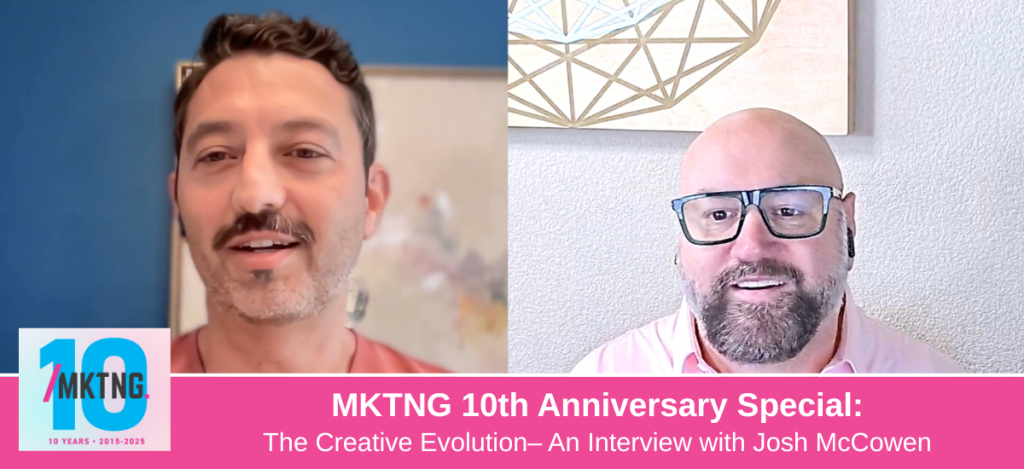MKTNG 10th Anniversary Special: The Creative Evolution – An Interview with Josh McCowen

Host Scott Eggert and Creative Director Josh McCowen discuss the evolving creative landscape over the last decade, noting the massive shift from print design to digital platforms like social media and websites. While embracing the speed of modern tools like Figma and Photoshop, Josh stresses the continued importance of fundamental creative strategy and manual processes, such as sketching on paper, to generate recall and meaningful ideas. The conversation zeroes in on the opportunities and challenges posed by the modern social environment, using the Cracker Barrel rebrand as an example of how public opinion can impact even established brands. They dive deep into the pervasive influence of AI (like Midjourney), which Josh uses as a technical and coding partner, but caution that current AI tends to produce “remarkably average” content and lacks the essential strategic perspective needed for truly great branding. Finally, Josh shares his work on his new venture, A Remembered Life, and wraps up the discussion with a quick “Keep or Kill” lightning round, where he keeps most design concepts but kills Papyrus and direct mail. Key Topics: The Evolution of Design and Marketing The Importance of Manual Creative Process The Impact of Social Media on Branding Defining a Brand AI’s Role in Creative Workflow Limitations and Caveats of AI The Future of Technology in Business Entrepreneurship and New Ventures “Keep or Kill” Design Concepts Personal Creative Pursuits Transcript: Scott: All right. So what does it take to build a brand that lasts? We’re exploring that very question today on the MK ten podcast. I’m the host, Scott Agar, president of MK tag. And I couldn’t think of a better person to discuss this with. And uh, our, my friend and our creative director, Josh McCown, uh, who’s been, uh, fostering, uh, innovation and working with collaborative, uh, teams from doing global brand launches and innovative digital experiences, his work has consistently pushed the boundaries. I can’t wait to dive into the story of creative evolution with him. Josh, it’s great to have you here. Welcome to Mk2 G10. This is a series you put together just to celebrate our ten years, and Josh is a cool part of that story. Cool. Glad to be here. Yeah. Yeah. So, uh, since we’re, you know, ten years, uh, for our outfit here, we, like, we’ve been kind of talking to, uh, you know, everybody on our team, uh, and some previous team members, kind of about what has changed in your tenure, uh, as a designer, what’s something that, uh, you know, you used to do that would just seem archaic, uh, if you were to, you know, pick up that tool or technology and use it today. Josh: I mean, I think the biggest thing for me is, as broadly as it sounds, print, um, which I desperately miss. Um, certainly there’s large brands that still do a lot of print work and, you know, you still see print, but, you know, working with modern tech startups today, a lot of companies, they’re all digital. It’s social media, it’s a website, it’s email. And that’s as far as they take their brand and marketing touchpoints. Obviously brick and mortar shops, things like that, restaurants, you know, anything where there’s a human in person, there’s still going to be some type of collateral. But yeah, I, I wish, I wish more brands to still did print design. Um, that was my initial, uh, endeavor into the design world was illustration and building brochures and annual reports and things like that. Um, but today we we pretty much just do websites and social media and applications and, you know, much more of a digital world these days. Scott: Yeah. Like is there. Are there any tools or a process that you do now that’s just like 180 degrees from how you used to do things? Josh: Um, I’m sure there is. I’m trying to think if there is something that we did like so manually that I got replaced. I mean, obviously we’ll touch on it as the conversation goes on, but AI is changing some of our kind of baseline processes. But I think from a kind of fundamental creative process understanding, uh, discovery process, a lot of the things that we do, or at least I do, I try to kind of maintain some of those best practices from, from before because they weren’t, you know, the tools can help us move faster, but they’re not going to answer our questions. They’re not going to know our insight. They’re not going to be able to pull out some of the things that, you know, you and I and some other, uh, industry people that have been in the around as long as we have the knowledge that we have. So, you know, I maybe don’t sketch as much as I used to on paper, um, when I’m working on maybe collateral or logos and things like that. But, you know, we still use Photoshop. Maybe not as much as we used to in the past. Um, but yeah, I, I can’t think of anything, like, so obvious. And maybe that’s the problem. Maybe there’s something that just it just disappeared, you know, over time. So inherently. But yeah, I, I still love a lot of the manual touchpoints of, of the work. You know, I think that’s one of the things that I enjoy doing the most is the actual creative work, not just the management of it or the direction of it, but actually getting my hands dirty. Um, so yeah, I think. I think my process is maybe the same for the most part. You know, maybe sped up with technology. Scott: Yeah. You mentioned, uh, sketching, which is interesting. Um, probably ten years ago. Right? Like we all thought, oh, we’re all going to start doing that on tablets. Like, did that ever work for you? Did you ever use a digital thing
CleanStart Perspectives – Build Better Content Using AI

I recently had the opportunity to give a presentation for CleanStart’s Perspectives podcast series. The topic was “Build Better Content Using AI,” and it was a fantastic discussion with an audience of startups, creatives, marketers, and nonprofit professionals. During the session, we explored how to use AI to develop content that resonates with your audience and drives real results for your organization. We focused on strategies for amplifying your brand voice in a way that remains authentic and human-centered. The goal was to provide tools, tips, and AI strategies that can help you: – Build content that connects with the right people – Grow your brand or organization with intention – Save time with AI without losing your authentic voice – Turn your message into momentum – In this presentation I shared some of our favorite tools and resources for generating AI content. Below is the infographic I created and walked through during our talk. Here is our MKTNG In the Loop, AI-generated podcast. We use and recommend JellyPod for creating AI podcasting in lieu of NotebookLM. Podcastle is our preferred platform for long form podcast recording and editing. Opus Clip is our preferred tool for our short clip editing It was an inspiring session, and a great chance to connect with the greater Sacramento clean tech community. I’m excited to see how everyone uses these insights to create impactful content that sticks. Connect with CleanStart for more events and information on the clean tech community in the Sacramento Region.
MKTNG 10th Anniversary Special: A Decade of Public Relations Changes– An Interview with Laura Braden

Laura Braden, a veteran in marketing and strategic communications with 20 years of experience, joins the MKTNG 10 Year Podcast to discuss the evolution of the PR and marketing landscape. She shares insights from her extensive career, including her roles as Director of Communications for the Campaign on Trauma Informed Policy and Practice, Senior Director of Communications for the Sacramento Kings, and Deputy Communications Director for Governor Arnold Schwarzenegger. Laura also founded Girls on the Grid, a prominent Sacramento social scene hub. The conversation covers significant shifts in communication practices, the principles of effective communication, challenges and opportunities in infrastructure project communications, and unique considerations for trauma-informed organizations. The episode concludes with a discussion on the impact of AI and the decentralization of media on the future of strategic communications. Key Topics: MKTNG’s 10th Anniversary Evolution of PR and Marketing Early Social Media Adoption Principles of Effective Communication Infrastructure Project Communications Trauma-Informed Communication Impact of AI on Strategic Communications Decentralization of Media Future of Communications Ethical Considerations of AI Transcript: Scott: All right. Welcome to a special episode of our podcast and MKTNG10, marking our ten year anniversary of MKTNG. Our marketing and PR agency that’s been crafting strategies for brands that care for over a decade. Today, I’m excited to chat with Laura Braden, a valuable team member at MKTNG, and a long time friend whose 20 years of expertise in marketing and strategic communications has made a huge impact in our field. Laura’s career is full of incredible highlights here in in Sacramento and beyond. She currently serves as the Director of Communications for the Campaign on Trauma Informed Policy and Practice. Well, that aligns very closely with our mission here at MKTNG to drive meaningful change through strategic communications. Laura has also left her mark on some pretty defining chapters and the Sacramento region. She served as senior Director of communications for the Sacramento Kings, where she steered all the PR and media for business operations. She also served as deputy communications director for Governor Arnold Schwarzenegger, crafting state, national and international campaigns on economics, infrastructure, energy, agricultural policies. You know that she also founded girls on the grid, once the preeminent hub for Sacramento social scene. Laura has worked for fortune ten companies, political campaigns, state agencies like California medical associations, nonprofits. And she remains a go to consultant for organizations and individuals, often in a time of crisis. I first connected with Laura through my role as president of the Social Media Club a long time ago here in Sacramento. This was when Laura was helping to organize a grassroots effort to keep the Kings here in Sacramento. We’ve remained friends since, and Laura has always remained a source of sharp insights with thoughtful and impactful intentions, which I’ve always valued. Today we’re diving into how marketing and PR well, the landscape has evolved over the past decade and the trends that are shaping our work now and what we see on the horizon. Laura, it’s great to have you here. So let’s jump in. Laura: Thanks for having me. Lovely intro. Yeah. Well, thanks. Scott: All right. So, uh, how are you doing today? Laura: Good. Good. Really ready to dive into some of the things that you and I have been chatting on offline about for a couple of years now. So. Yeah, let’s do it. Scott: Yeah, absolutely. So this is, uh, you know, uh, ten, ten and ten year anniversary for MKTNG, which is, uh, just recently passed. So we’re we’re kind of looking back, right? We want to talk about what’s happened in ten years. And because kind of our careers in general. Right. You both go back a ways. Um, and I wanted to we’ll get to sort of some new tools, right, that are shaping communications. But what’s something, uh, like what’s a relic of your past? Like, what’s a tool you remember using back when, when you were first, uh, starting in public relations? Laura: Well, as you were so kind to say, I am. Yes, almost. I’m approaching my 25th anniversary of being in this world, which is just. Well, that’s an entire lifetime that I’ve been doing this now. So that’s pretty surreal. So as you can imagine, you know, back in, gosh, 2000, 2001 when I got started, one of my favorite things to highlight for folks, especially the younger folks who, you know, don’t really use fax machines and that sort of thing. But, uh, one major thing that has changed is the way that we even distribute press releases and all that. So way back in the day, early 2000, we would fax press releases to newsrooms one by one. We would, um, we would take this was sort of before the internet was ubiquitous. Um, and it was really hard for newspapers, didn’t quite know what the others were covering necessarily. So you could take one off then and we would pitch it at the same time to the Boston Globe, The Washington Post, The New York Times, the Chicago Tribune, all the bigs. And then we would wait for our service to send us in the mail a three ring binder, uh, that op ed placement, as well as any other, uh, you know, media placements for the client. Um, And it would be the actual hard copy from the newspaper cut out posted. And then we would take that three ring binder and make copies of it, and then find it again, and then get it to the client. So as you can imagine, I mean, that’s a lot of jobs, a lot of cottage, you know, little small businesses that it’s supporting because there were probably like four different vendors in that process. But it would take weeks, would take forever. And nowadays, you know, you can’t get away with that. Everybody wants their own unique content exclusivity, especially when it comes to things like
Empowering Voices: The Crucial Role of Trauma-Informed Communications in Survivor Storytelling

As communications and marketing professionals, we can amplify voices, shape narratives, and drive social change. But with that power comes a profound responsibility—especially when working with trauma survivors. By adopting trauma-informed approaches, we can ensure our storytelling empowers rather than exploits and heals rather than harms. Why Trauma-Informed Communications Matter Trauma is pervasive in our society. Studies show that 70% of U.S. adults have experienced at least one traumatic event. For many, sharing their story can lead to healing and positive change. However, if done carelessly, it risks re-traumatization. Traditional journalistic approaches often prioritize getting “the scoop” over survivor well-being. As communicators, we must hold ourselves to a higher standard. Trauma-informed communications shift the paradigm from “What’s wrong with you?” to “What happened to you?” and then to “What’s strong with you?” It views survivors as whole people deserving of dignity, not just sources for dramatic quotes. This approach leads to more accurate, nuanced storytelling. Trauma impacts memory and perception. By creating safe, supportive environments for survivors to share at their own pace, we get fuller, more reliable accounts without causing further harm. Concrete Steps for Trauma-Informed Storytelling Prioritize Informed Consent: Clearly explain how you’ll use their story, what questions you’ll ask, and their rights in the process. Give them time to consider before agreeing. Collaborate, Don’t Dictate: Share questions in advance. Let survivors choose what they’re comfortable answering. Allow them to review and approve their quotes. Create a Safe Environment: Let them choose the interview location. Explain the logistics in advance (duration, recording methods, etc.). Offer breaks. Ask Open-Ended Questions: Instead of “How do you feel?”, try “How are you today?” or “How did you experience that?” Respect Boundaries: Don’t pressure them if they decline or seem hesitant. Provide your contact info in case they change their mind later. Focus on Strength and Resilience: While acknowledging pain, highlight growth, coping strategies, and hopes for the future. Give Them Control: Ask what they hope to achieve by sharing their story. Shape your piece around their goals. Avoid Sensationalism: Avoid unnecessary graphic details that could trigger readers or the survivor upon publication. Follow-up: Stay in touch about how their story is used. If you plan future coverage, always inform them first. Care for Yourself: Secondary trauma is real for communicators, too. Practice self-care and seek support when needed. Embracing trauma-informed communications requires a shift in mindset throughout our organization: Educate all staff on trauma basics and its impacts on memory, behavior, and healing. Develop clear policies on ethical storytelling and survivor interactions. Prioritize long-term relationships with survivors over “one and done” stories. Measure success beyond clicks and views. Consider how our work impacts survivors and communities. Create space for reflection and learning. Debrief challenging stories as a team. The Impact of Trauma-Informed Storytelling When we approach survivor stories with empathy, respect, and collaboration, remarkable things happen: Survivors feel empowered, not exploited. Our stories become richer, more nuanced, and ultimately more impactful. We build trust with vulnerable communities, opening doors for future partnerships. Our work actively contributes to healing, both for individuals and society. By embracing trauma-informed practices, we don’t just avoid harm—we become agents of positive change. We shift from merely telling stories to facilitating healing and transformation. This requires more time, care, and intention, but the impact is immeasurable. Ready to get started? Contact us today—Call 855-MKTNGCO or click here!! GO DEEPER: Trauma-Informed Journalism (CTIPP) Survivor Storytelling (National Survivor Network) Whose story, whose benefit? Returning (to) the power of authentic narrative (University of Liverpool) The Power of Trauma-Informed Communications & Marketing: Why CEOs Must Embrace This Approach (MKTNG) Integrating Trauma-Informed Principles Into Your Internal Communications & Workplace Culture (MKTNG) (AI Disclaimer: proofed by Grammarly and lightly edited using Claude)
